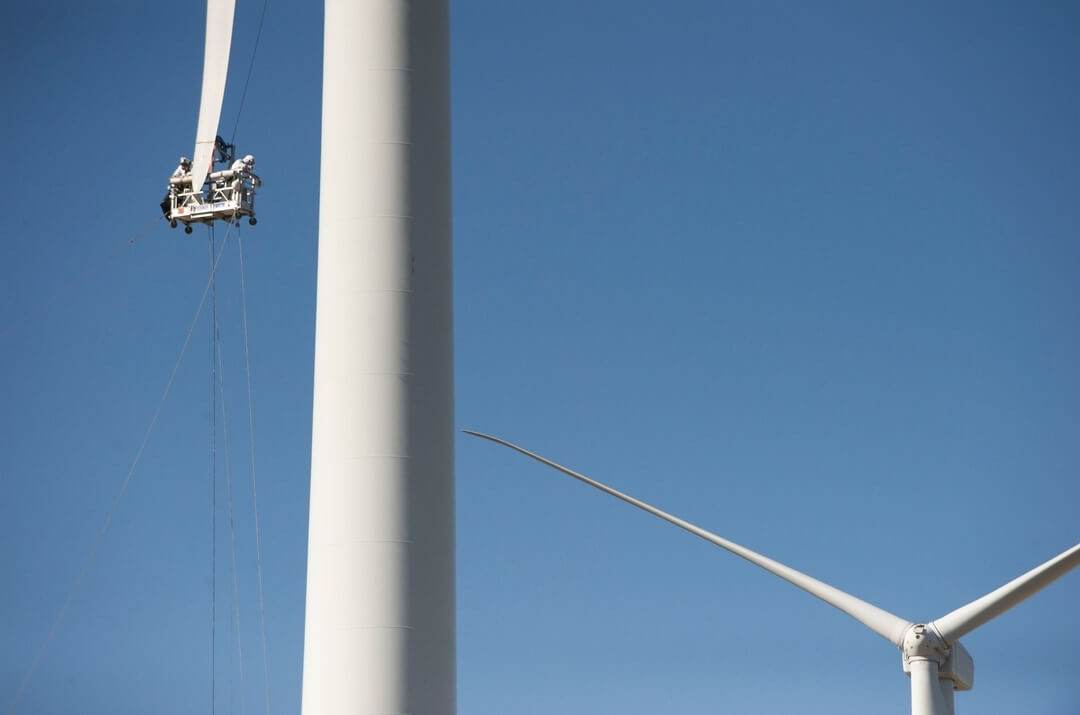
GWO members developed the Basic Safety Training Standard in 2012 and today more than 70,000 people, including over 1000 Americans have received the training. The organization’s new Blade Repair Standard is scheduled for release in April of this year. Learn more on the Global Wind Organisation’s website.
Every construction site presents certain risks or hazards and this is particularly true of wind sites. Wind farms pose a safety challenge to techs and engineers because of the chance of falls and dropped objects. The harsh conditions typical at wind sites only heighten these concerns. Strong wind gusts or frigid temperatures can quickly and unexpectedly threaten a site’s level of safety.
To mitigate such hazards, Global Wind Organisation (GWO) has been working diligently to promote and increase safety standards in the wind industry. GWO is a non-profit, member-based organization established by wind-turbine manufacturers and owners. Members collaborate by sharing evidence and risk information and, according to the GWO, this helps the industry “identify work activities where the creation of standardized training can enhance safety for technicians and deliver various productivity benefits.”
A worldwide network of certified training providers is essential to delivering GWO standard training. At the start of 2019, there were nearly 300 training sites in 37 countries. Just last year, 68 new sites opened, including three new training facilities in the United States and one in Canada. An additional six U.S. training sites are expected to gain certification over the next 18 months as the country’s supply chain gears up for offshore wind on the Eastern Seaboard.
GWO recently released its 2019 work plan that includes several enhanced “task specific” training standards.
“Our work plan in 2019 is agreed upon by 16 leading global companies that are the world’s largest employers in wind energy,” said Eloy Jauregui, Chairman of GWO and Safety Director of Acciona Energia. There will be a mixture of projects reaching completion — like the Blade Repair Standard.”
Jauregui refers to the wind industry’s first global training standard for blade repair technicians, set for release on April 1, 2019. The GWO Blade Repair Standard Working Group is currently pilot testing the training, which aims to align the training programs of different manufacturers and deliver a standard benchmark of skills for blade inspection and repair technicians.
Another priority for GWO is aligning its standards with other similar training programs in the industry. For example, it has already completed this process against entry-level wind technician trainings from its members such as Vestas Service D and Siemens Level 1-4. Thanks to a short ‘gap training’ session, techs who’ve earned one of those manufacturers’ training can receive a GWO Basic Technical Training standard certificate, which is recognized by all 16 members of the organization.
“All GWO training can be merited against similar training by using gap analyses,” explains Jakob Lau Holst, CEO of GWO. “This identifies how similar the training is and if there are any gaps where the existing training needs to be ‘topped up.’ On the other hand, a training course could deliver all the learning objectives of a GWO standard already and the technician deserves a GWO certificate.”
The important thing, explains GWO, is that standards are about comparing apples with apples.
“We are speaking with organizations across the United States, such as labor unions and other training bodies who already deliver courses,” says Lau. “If their training can be compared to a GWO standard and the differences ironed out, it will benefit everyone because we all recognize the same thing.”
The final piece of the puzzle at GWO is the way certificates are awarded and stored. Certified training providers upload them to WINDA, the wind industry database. WINDA then helps employers verify the status of GWO-certified training providers and the training status of delegates who have attended GWO training courses.
Information about WINDA is available here.
Filed Under: News, Safety, Training




